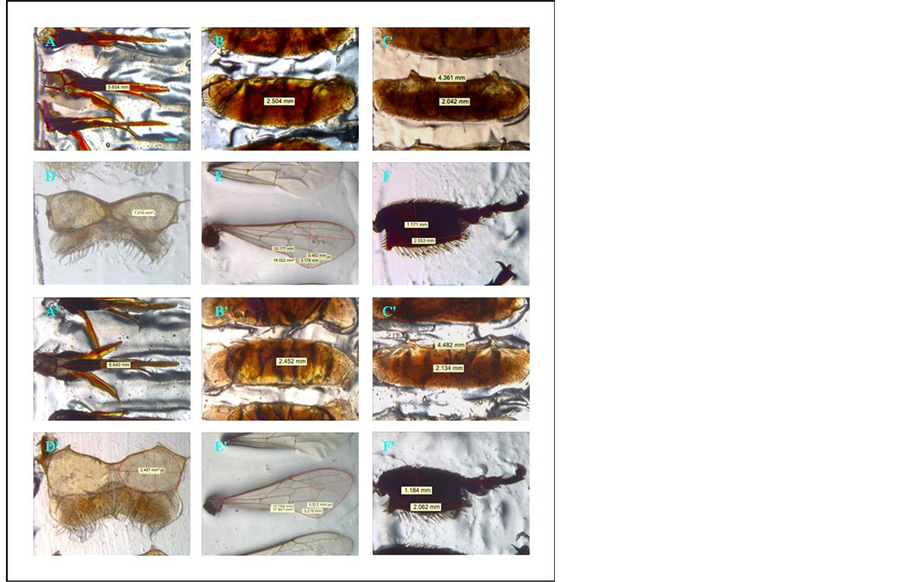摘要:
为了积累远东黑蜂的形态学数据,和以此数据为依据表征远东黑蜂,本研究首先通过显微图像分析方法分别测定了10群远东黑蜂样本和10群欧洲黑蜂样本各自的13项尺度类形态学指标;其次,通过F-分析比较了远东黑蜂样本测定值均数与欧洲黑蜂样本测定值均数的离散程度,通过t-检验比较了远东黑蜂样本测定值均数与欧洲黑蜂样本测定值均数的差异性。远东黑蜂样本的吻长度、第四蜡镜宽度、第四蜡镜面积测定值均数,都明显地小于欧洲黑蜂样本的相应测定值均数(P < 0.05);相反,它们之间的第三背板宽度、第四背板长度、第四背板宽度、第四蜡镜长度、前翅长度、前翅宽度、前翅面积、前翅肘脉指数、后腿跗节长度以及后腿跗节宽度测定值均数,都没有差异(P > 0.05)。这提示,相对于欧洲黑蜂,远东黑蜂具有明显的形态学体征:短的吻长度,短的第四蜡镜宽度和小的第四蜡镜面积。
Abstract: A Microscopic image analysis was conducted to collect a set of morphometric data for characterizing morphological features of Far East Blank Bee. First of all, we measured 13 indexes of morphometry of 10 colonies of both Far East Blank Bee and Apis mellifera mellifera, respectively. Then we compared discreteness of means of measured values between them, and compared difference of the means between them. Compared to samples of colonies of Apis mellifera mellifera in the measurements of proboscis length, width and surface area of wax mirror IV, samples of colonies of Far East Blank Bee are showed with shorter proboscis, shorter wax mirror IV, and smaller surface area of wax mirror IV (P < 0.05, respectively). On the contrary, compared to samples of the former with the measurements of the others, samples of the latter are not showed with significant differ-ence of measurements, including width of tergum III, both length and width of tergum IV, length of wax mirror IV, length, width, surface area, cubital index of forewing, and both length and width of metabasitarsus hindleg (P > 0.05, respectively). The present analysis could distinguish the mor-phometric difference between the samples of colonies of both Far East Blank Bee and Apis mellifera mellifera.
1. 引言
俄罗斯远东蜜蜂(Russia Far East Bee),国内文献多称之为远东黑蜂(Far East Black Bee),国外文献多称之为俄罗斯蜜蜂(Russia honeybee),是欧洲人于19世纪中期向俄罗斯远东地区移居时引入的西方蜜蜂[1] [2] 。在一百五十多年进化过程中,远东黑蜂在适应当地冬季寒冷气温和经历漫长越冬期的基础之上具备了抗寒性;同时,这个地区位于东方蜜蜂分布地域的最北端,远东黑蜂与当地东方蜜蜂地方类群形成了种间同域物种,它们之间的种间竞争促进远东黑蜂逐渐演变成为螨(特别是大满)的寄生宿主[3] -[7] 。因此,远东黑蜂既保留了西方蜜蜂所具有的蜂蜜高产这个农艺性状,同时获得了东方蜜蜂所具有的抵抗寒冷气候和螨侵袭的生物学特征[8] 。美国于1997年引入远东黑蜂,并于2009年开始在全国范围内推广含有部分远东黑蜂血统的商业用种蜂王[9] 。
西方蜜蜂具有庞大的地方类型家族成员,西方蜜蜂形态变异分析(结合西方蜜蜂系统地理学分析)鉴定了不少于24~29个西方蜜蜂地方类型,并且大致将它们归纳为非洲世系、西部欧洲世系、东部欧洲世系和亚洲世系[10] [11] 。比之于西方蜜蜂西部欧洲世系,西方蜜蜂东部欧洲世系能够充分适应全球不同的地理、气候以及生态环境,并且形成了西方蜜蜂最复杂的种内系统关系[11] 。远东黑蜂可能属于西方蜜蜂东部欧洲世系。比如,Rinderer和Collins (1976)根据俄罗斯远东地区的养蜂历史文献记载认为远东黑蜂是乌克兰蜜蜂(Apis mellifera acervorum)的后代[12] 。我国一些学者也认为,远东黑蜂很有可能是东部欧洲世系内不同地方类型之间的杂交种,或者在此遗传背景之上含有欧洲黑蜂血统[13] 。
然而,迄今为止,国内外相关领域尚缺乏远东黑蜂形态变异分析的文献报道。为了积累远东黑蜂的形态学数据,和以此数据为依据表征远东黑蜂,本研究首先通过随机抽样方法从远东黑蜂保种群和欧洲黑蜂保种群中各指定10群蜜蜂,通过选择抽样方法从每一群蜜蜂中采集60只体色一致、形体均一的工蜂;其次,通过显微图像分析方法测定了每一只工蜂的13项尺度类形态学指标;最后,通过F-分析比较了上述指标测定值均数的离散性,以及通过t-检验比较了它们的差异性。
2. 材料与方法
2.1. 实验设计
本研究包括室内试验和室外试验两部分。野外实验主要包括远东黑蜂样本和欧洲黑蜂样本的取样和取样方法;室内实验主要包括样本的昆虫外部器官解剖及载玻片制作,样本的形态学指标测定及指标测值记录,以及样本的测定数据归纳及统计学检验。
2.2. 取样及取样方法
俄罗斯远东海冰边疆地区(北纬:42˚20'~48˚25',东经:130˚20'~139˚)是远东黑蜂的诞生地,俄罗斯乌拉尔山脉近基洛夫地区(北纬:56˚03'~61˚04',东经:41˚17'~53˚56')是欧洲黑蜂的主要分布区。在相同的蜜蜂繁殖季节(即,2012年7月),通过随机抽样方法,分别从分布于上述俄罗斯地区的远东黑蜂保种群和欧洲黑蜂保种群中指定10群蜜蜂,通过选择抽样方法,从每一群蜜蜂中采集60只体色一致、形体均一的工蜂,浸泡于盛有75%乙醇的250-ml型标本瓶中。
2.3. 昆虫外部器官解剖及载玻片制作
参照西方蜜蜂解剖图谱[14] ,用眼科手术镊子和剪刀依次将吻、第三背板、第四背板、第四蜡镜、右前翅以及右后腿从相应部位解剖出来,并且浸泡于30%乙醇溶液。
依据载玻片涂片法的实验步骤,分别将吻、第三背板、第四背板、第四蜡镜、右后腿远端跗节固定于甘油中;依据载玻片滴片法的实验步骤,将右前翅固定于去离子水中。每一张载玻片承载20~25个相同类型的蜜蜂解剖器官。
2.4. 形态学指标测定及指标测值记录
M165FC-型计算机辅助显微图像分析系统(德国,徕卡)具有图像捕获和数据处理两个应用软件。前者通过多通路光学-数字转化功能将载玻片承载的蜜蜂解剖器官自动录入Excel文档,并且按照先后顺序在Excel文档自动排列图像;后者通过线性指标测定功能依次对排列图像进行长度测定,并且将指标测定值按照指标分类类别形式自动记录于Excel文档。在进行长(或宽)度指标测定过程中,用计算机鼠标选择长(或宽)度测定选项,并在待测样品图像的测定位置点击一个起点和一个终点,起点至终点的直线距离即为待测样品的长(或宽)度测定值;在进行面积指标测定过程中,用计算机鼠标选择面积测定选项,并在待测样品图像的测定位置沿面积边缘将曲线分解为若干直线,点击每一条直线所对应的一个起点和一个终点,每一起点至终点的直线距离所覆盖的区域大小即为待测样品的面积测定值。本研究通过上述方法分别测定了每一只远东黑蜂样本和每一只欧洲黑蜂样本的吻长度,第三背板宽度,第四背板长度和宽度,第四蜡镜长度、宽度和面积,前翅长度、宽度和面积,以及跗节长度和宽度。此外,本研究通过计算前翅肘脉-A段长度与肘脉-B段长度之比分别测定了每一只远东黑蜂样本和每一只欧洲黑蜂样本的前翅肘脉指数。
2.5. 测定数据归纳及统计学检验
首先,通过计量资料指标统计方法,将上述指标测定值归纳为均数和标准差,并且记录于Excel文档。其次,通过S-PLUS统计软件(S-PLUS 6)的F-分析模块,比较远东黑蜂样本测定值均数与欧洲黑蜂样本测定值均数的离散程度;通过S-PLUS统计软件的t-检验模块,比较远东黑蜂样本测定值均数与欧洲黑蜂样本测定值均数的差异性。在利用S-PLUS统计软件进行测定数据的分析过程中,首先从分析模块数据库中选择代表F-分析模块和t-检验模块的代码指令,并分别将这些代码指令以相应格式输入计算机;然后将待比较的上述Excel文档导入统计软件。当概率P值 < 0.05时,比较结果有差异;当概率P值 > 0.05,比较结果无差异。
3. 结果
头部下端吻、腹部背侧第三背板、腹部背侧第四背板、腹部腹侧第四蜡镜、右侧前翅、右侧后腿远端跗节等蜜蜂外部器官是进行西方蜜蜂形态变异分析公认的研究对象。在本研究中,我们通过参考西方蜜蜂解剖图谱,从每一只远东黑蜂样本和每一只欧洲黑蜂样本的解剖部位准确地获取了吻、第三背板、第四背板、第四蜡镜、前翅和后腿远端跗节;其次,通过计算机辅助显微图像分析系统的图像捕获软件,分别将上述解剖器官完整地录入计算机分析系统。
吻长度等13项尺度类蜜蜂形态学指标是进行西方蜜蜂形态变异分析公认的研究指标。在本研究中,我们通过计算机辅助显微图像分析系统的数据处理软件,分别测定了每一只远东黑蜂样本和每一只欧洲黑蜂样本的吻长度(图1,A-A')、第三背板宽度(图1,B-B'),第四背板长度和宽度(图1,C-C'),第四蜡镜长度、宽度和面积(图1,D-D'),前翅长度、宽度、面积和肘脉指数(图1,E-E'),以及跗节长度和宽度(图1,F-F')。在此基础之上,我们将每一群蜜蜂的不同类型测定数据转化为相应的均数和标准差(附录表A1)。

Figure 1. Image of 6 pairs of external dissect organs of Far East Black Bee and Apis mellifera mellifera
A~F,远东黑蜂;A'~F',欧洲黑蜂。A~A',吻;B~B',第三背板;C~C',第四背板;D~D',第四蜡镜;E~E',前翅;F~F',后腿远端跗节。“—”:微米级分辨率
图1. 远东黑蜂样本、欧洲黑蜂样本的6对外部解剖器官
欧洲黑蜂是较少受西方蜜蜂基因流影响的一个西方蜜蜂地方类型,在进行西方蜜蜂形态变异分析中,它通常充当实验对照[11] 。在本研究中,我们分别通过F-分析和t-检验,先比较了远东黑蜂样本测定值均数与欧洲黑蜂样本测定值均数的离散程度,后比较了远东黑蜂样本测定值均数与欧洲黑蜂样本测定值均数的差异性。前者结果显示,远东黑蜂样本的测定值均数与欧洲黑蜂样本的测定值均数具有相同的离散性(结果未给出);后者结果显示,远东黑蜂样本的第三背板宽度、第四背板长度、第四背板宽度、第四蜡镜长度、前翅长度、前翅宽度、前翅面积、前翅肘脉指数、后腿跗节长度、后腿跗节宽等测定值均数,近似于欧洲黑蜂的相应测定值均数,而且,它们测定值均数之间没有差异(P > 0.05) (表1;图2)。相反,远东黑蜂样本的吻长度、第四蜡镜宽度、第四蜡镜面积等测定值均数,都明显地小于欧洲黑蜂样本的相应测定值均数,而且,它们测定值均数之间有差异(P < 0.05) (表1;图2)。

Table 1. A list of 13 morphological characteristics (size) of Far East Black Bee and Apis mellifera mellifera
表1. 远东黑蜂、欧洲黑蜂的13项(尺度)类形态学指标测定值统计表
注释:SCM, size characters of morphometry; No., number; M, mean; SD, standard deviation; LP, length of proboscis (mm); WT 3, width of tergum III; LT 4, length of tergum IV; TT 4, width of tergum IV; LWM 4, length of wax mirror IV; WWM 4, width of wax mirror IV; SAWM 4, surface area of wax mirror IV (mm2); LFW, length of fore wing; WFW, width of forewing; SAFW, surface area of fore wing; CIFW, cubital index of fore wing (ratio); LMH, length of metabasitarsus, hindleg; WMH, width of metabasitarsus, hindleg.

Figure 2. Comparison of 13 morphological characteristics (size) between Far East Black Bee and Apis mellifera mellifera
A,吻;B,第三背板;C,第四背板;D,第四蜡镜;E,前翅;F,后腿远端跗节。*,p值 < 0.05。
图2. 远东黑蜂、欧洲黑蜂样本的13项(尺度)类形态学指标测定值比较
4. 讨论
欧洲黑蜂在欧洲向东方向的地理分布极限地域是位于俄罗斯西部平原(欧洲部分)与东部高原、山地(亚洲部分)之间的乌拉尔山脉,即,俄罗斯中部地区[8] ;同时,这个地区也是西方蜜蜂自然分布地域的最东端[11] [15] 。在本研究中,欧洲黑蜂样本来自俄罗斯中部地区的欧洲黑蜂保种群,远东黑蜂样本来自俄罗斯远东地区的远东黑蜂保种群。它们形态学指标测定值之间的比较分析,实质上是比较西方蜜蜂种内两个同域物种样本之间的形态学体征。鉴于西方蜜蜂西部欧洲世系与东部欧洲世系之间存在部分生殖隔离[16] [17] ,本研究从远东黑蜂与欧洲黑蜂的比较分析中,积累了远东黑蜂的形态学数据,并且以此数据为依据表征了远东黑蜂。
动物组织学根据蜜蜂不同器官的组织特征将蜜蜂各器官概括为内部软组织器官和外部硬组织器官 [18] 。相对于蜜蜂内部软组织器官,蜜蜂外部硬组织器官直接感知寒冷气温等环境胁迫因子,并且产生多种生理反应[11] 。在本研究中,我们选择头部下端吻、腹部背侧第三背板、腹部背侧第四背板、腹部腹侧第四蜡镜、右侧前翅、右侧腿部远端跗节等6个蜜蜂外部器官作为研究对象。
西方蜜蜂形态变异分析通常涉及35至42项蜜蜂形态学指标,这包括13~16项尺度类形态学指标[19] [20] 。越来越多的证据表明,昆虫尺度类形态学指标是度量昆虫外部器官在环境选择压力作用下发生变化的综合指标[11] [21] [22] 。在本研究中,远东黑蜂样本的第三背板镜宽度等10项蜜蜂形态学指标测定值均数,与欧洲黑蜂样本的相应测定值均数都没有统计学差异,这说明,基于第三背板宽度等10项蜜蜂形态学指标的蜜蜂形态变异分析没有发现远东黑蜂与欧洲黑蜂之间存在体征差异。
然而,在本研究中,基于吻长度、第四蜡镜宽度和第四蜡镜面积的蜜蜂形态变异分析,发现了远东黑蜂与欧洲黑蜂之间存在体征差异。在13~16项蜜蜂尺度类形态学指标中,吻长度是反映寒冷气温等环境胁迫因子影响蜜蜂形态变异最敏感的形态学指标之一[11] 。Mărghitas等(2008)通过测定蜜蜂吻长度发现,相对于罗马尼亚非寒冷地区的喀尔巴阡蜜蜂生态类型,罗马尼亚寒冷地区的喀尔巴阡蜜蜂生态类型具有短的吻[23] 。在本研究中,我们发现,相对于欧洲黑蜂,远东黑蜂具有短的吻。这可能是俄罗斯远东地区的寒冷气温主要影响了蜜、粉源植物的花冠形态,蜜蜂吻伴随花冠形态变化产生了协同进化效应。
在寒冷气温地区,蜜蜂繁殖期缩短是蜜蜂适应低温胁迫出现的主要生殖生理反映,这也可能涉及第四蜡镜的形态改变。在蜜蜂筑巢过程中,工蜂腹部泌蜡腺体向体外持续分泌蜡质,蜡镜充当了临时承载蜡质的“贮存库”,它们共同构成了工蜂生产蜡质的泌蜡器官[24] 。而且,如同意大利蜜蜂工蜂泌王浆腺体伴随蜂群繁殖期延长出现了分泌活动增强和体积增大现象,意大利蜜蜂工蜂泌蜡器官伴随蜂群繁殖期延长也出现了分泌活动增强和体积增大现象。在本研究中,我们发现,相对于意大利蜜蜂,欧洲黑蜂具有短的第四蜡镜宽度和小的第四蜡镜面积(结果未给出);同样,相对于欧洲黑蜂,远东黑蜂具有短的第四蜡镜宽度和小的第四蜡镜面积。这可能反映了远东黑蜂工蜂伴随蜂群繁殖期缩短出现了泌蜡器官分泌活动减弱和体积减小现象。
5. 结论
总之,上述分析显示,远东黑蜂样本的第三背板宽度、第四背板长度、第四背板宽度、第四蜡镜长度、前翅长度、前翅宽度、前翅面积、前翅肘脉指数、后腿跗节长度、后腿跗节宽度测定值均数,近似于欧洲黑蜂的相应测定值均数,而且,它们测定值均数之间都没有统计学差异。相反,远东黑蜂样本的吻长度、第四蜡镜宽度、第四蜡镜面积测定值均数,都明显地小于欧洲黑蜂样本的相应测定值均数,而且,它们测定值均数之间都有统计学差异。据此,本文认为,相对于欧洲黑蜂,远东黑蜂可能具有明显的形态学体征,即,短的吻长度,短的蜡镜宽度和小的蜡镜面积。
基金项目
国家自然科学基金项目(31050006,31350006)、吉林省科技发展计划项目(20100719)以及国家蜂产业技术体系项目(CARS-45-KXJ2)。
附录(Appendix)




Table A1. A list of 13 morphological characteristics (size) of each colony of Far East Black Bee and each of Apis mellifera mellifera
表A1. 每群远东黑蜂、欧洲黑蜂的13项(尺度)类形态学指标测定值统计表